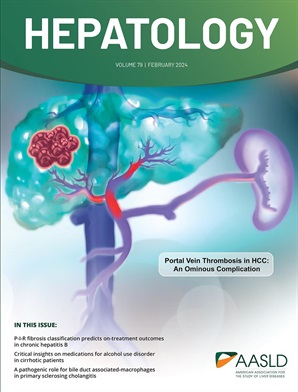The de-sulfinylation enzyme sulfiredoxin-1 attenuates hepatic stellate cell activation and liver fibrosis by modulating the PTPN12-NLRP3 axis.
IF 12.9
1区 医学
Q1 GASTROENTEROLOGY & HEPATOLOGY
引用次数: 0
Abstract
BACKGROUND AIMS Liver fibrosis is characterized by the progressive scarring of liver tissue. Oxidative stress is a critical causal factor of hepatic stellate cell (HSC) activation and the subsequent liver fibrogenesis, but the mechanism is not fully understood. Cysteine sulfinic acid (Cys-SO2H), a modification of reactive cysteine residues, is a unique form of oxidative response that alters the structure and function of proteins. Sulfiredoxin 1 (SRXN1) is responsible for ATP-dependent reduction of the Cys-SO2H to sulfenic acid (Cys-SOH). APPROACH RESULTS We found that the expression of SRXN1 was increased in activated HSCs and in human and mouse fibrotic livers. HSC-specific ablation of Srxn1 or pharmacological inhibition of Srxn1 exacerbated HSC activation and sensitized mice to liver fibrosis. Mechanistically, SRXN1 inhibited HSC activation by de-sulfinylating the phosphatase protein tyrosine phosphatase non-receptor type 12 (PTPN12), which enhanced its phosphatase activity and protein stability, leading to decreased tyrosine phosphorylation and reduced activation of the pro-fibrotic inflammasome protein NLRP3. The anti-fibrotic effect of SRXN1 was abolished when NLRP3 was inhibited. In contrast, overexpression of PTPN12 attenuated NLRP3 activation, and this effect was further amplified by the C164A S-sulfinylation resistant mutant of PTPN12. CONCLUSIONS Our findings have uncovered an important role of SRXN1 and protein S-sulfinylation in HSC activation and liver fibrosis. The SRXN1-PTPN12-NLRP3 axis represents potential therapeutic targets for liver fibrosis.脱亚硫酰化酶 sulfiredoxin-1 通过调节 PTPN12-NLRP3 轴减轻肝星状细胞活化和肝纤维化。
背景 摘要 肝纤维化的特征是肝组织逐渐形成瘢痕。氧化应激是肝星状细胞(HSC)活化和随后肝纤维化的关键致病因素,但其机制尚未完全明了。半胱氨酸亚硫酸(Cys-SO2H)是活性半胱氨酸残基的一种修饰,是改变蛋白质结构和功能的一种独特的氧化反应形式。硫氧化还原酶 1(SRXN1)负责将 Cys-SO2H 还原成亚硫酸(Cys-SOH)。造血干细胞特异性消融 Srxn1 或药物抑制 Srxn1 会加剧造血干细胞活化并使小鼠对肝纤维化敏感。从机理上讲,SRXN1通过对磷酸酶蛋白酪氨酸磷酸酶非受体型12(PTPN12)进行脱亚硫酰化,从而增强其磷酸酶活性和蛋白稳定性,导致酪氨酸磷酸化减少,并降低了促纤维化炎性体蛋白NLRP3的活化,从而抑制了造血干细胞的活化。抑制 NLRP3 后,SRXN1 的抗纤维化作用就会消失。与此相反,过表达 PTPN12 可减轻 NLRP3 的活化,而 PTPN12 的 C164A S-亚磺酰化抗性突变体可进一步增强这种效应。SRXN1-PTPN12-NLRP3轴是肝纤维化的潜在治疗靶点。
本文章由计算机程序翻译,如有差异,请以英文原文为准。
求助全文
约1分钟内获得全文
求助全文
来源期刊

Hepatology
医学-胃肠肝病学
CiteScore
27.50
自引率
3.70%
发文量
609
审稿时长
1 months
期刊介绍:
HEPATOLOGY is recognized as the leading publication in the field of liver disease. It features original, peer-reviewed articles covering various aspects of liver structure, function, and disease. The journal's distinguished Editorial Board carefully selects the best articles each month, focusing on topics including immunology, chronic hepatitis, viral hepatitis, cirrhosis, genetic and metabolic liver diseases, liver cancer, and drug metabolism.
 求助内容:
求助内容: 应助结果提醒方式:
应助结果提醒方式:


